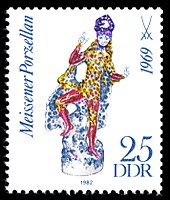Oberon (Elven King)
The figure of the elven king Oberon (corresponding to Alberich in Germanic mythology ) can be found for the first time in the French saga Les Prouesses et faitz du noble Huon de Bordeaux from the early 13th century, which belongs to the saga of Charlemagne .
The subject of the poem was later used by many English poets, such as Geoffrey Chaucer , Edmund Spenser and in the Midsummer Night's Dream by William Shakespeare . Based on this play, Oberon appears as a character in musical theater works by Henry Purcell ( The Fairy Queen ) and Benjamin Britten ( A Midsummer Night's Dream ). In 1787, the newly discovered Uranus moon Oberon was named after the literary character in Shakespeare's drama.
Johann Wolfgang Goethe took the characters from Shakespeare's work in the Walpurgis Night dream scene of Faust . Oberon is married to Titania and their golden wedding anniversary is described in Faust I.
In the 18th century, Christoph Martin Wieland used the figure in his romantic epic Oberon , based on which James Robinson Planché wrote the libretto for Carl Maria von Weber 's opera of the same name (see here ).
Another well-known author who used this name is Wolfgang Hohlbein . In his fantasy series Anders , the god of the Elder Oberon is called.
The term elf king was derived from the Danish word "ellerkongen". Johann Wolfgang von Goethe took the Elf King as a model for his ballad about the Erlkönig .
swell
- Oberon . Verserzählung, Weimar 1780 ( digitized and full text in the German text archive ); abridged version: Leipzig 1784.
- Max Koch : The source ratio of Wielands Oberon , Marburg 1880. https://archive.org/stream/dasquellenverhl00wielgoog Internet Archive

